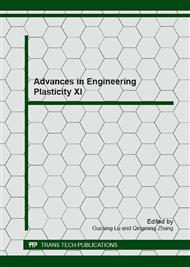p.201
p.205
p.211
p.215
p.219
p.223
p.227
p.231
p.235
Indentation Behavior of a Closed-Cell Aluminum Foam at Elevated Temperatures
Abstract:
A series of deep indentation and uniaxial compression tests of closed-cell aluminum foams at room temperature as well as elevated temperatures were conducted. A flat-ended punch (FEP) was used in the indentation tests. Cross-sectional views of the specimens after tests show that the deformation is roughly confined to the material directly underneath the indenter with slightly lateral spread. It is found that plastic collapse strength and energy absorption of the specimens are temperature dependent in both loading conditions. Tear energy of the foam in FEP indentation depends on the indentation depth and temperature.
Info:
Periodical:
Pages:
219-222
Citation:
Online since:
January 2013
Authors:
Price:
Сopyright:
© 2013 Trans Tech Publications Ltd. All Rights Reserved
Share:
Citation:


